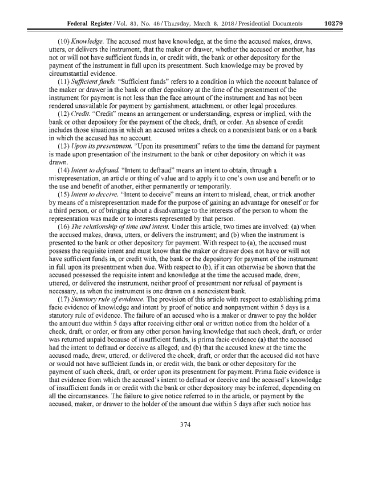Page 576 - Trump Executive Orders 2017-2021
P. 576
Federal Register / Vol. 83, No. 46 / Thursday, March 8, 2018 / Presidential Documents 10279
(10)Knmvledge. The accused must have knowledge, at the time the accused makes, draws,
utters, or delivers the instrument, that the maker or drawer, whether the accused or another, has
not or will not have sufficient funds in, or credit with, the bank or other depository for the
payment of the instmment in full upon its presentment. Such knowledge may be proved by
circumstantial evidence.
(11) Sufficient funds. "Sufficient funds" refers to a condition in which the account balance of
the maker or drawer in the bank or other depository at the time of the presentment of the
instrument for payment is not less than the face amount of the instmment and has not been
rendered unavailable for payment by garnishment, attachment, or other legal procedures.
(12) Credit. "Credit" means an arrangement or understanding, express or implied, with the
bank or other depository for the payment of the check, draft, or order. An absence of credit
includes those situations in which an accused writes a check on a nonexistent bank or on a bank
in which the accused has no account.
(13) Upon its presentment. "Upon its presentment" refers to the time the demand for payment
is made upon presentation of the instrument to the bank or other depository on which it was
drawn.
(14) Tntent to defraud "Intent to defraud" means an intent to obtain, through a
misrepresentation, an article or thing of value and to apply it to one's own use and benefit or to
the use and benefit of another, either permanently or temporarily.
(15) Tntent to deceive. "Intent to deceive" means an intent to mislead, cheat, or trick another
by means of a misrepresentation made for the purpose of gaining an advantage for oneself or for
a third person, or of bringing about a disadvantage to the interests of the person to whom the
representation was made or to interests represented by that person.
(16) The relationship (!{time and intent. Under this article, two times are involved: (a) when
the accused makes, draws, utters, or delivers the instrument; and (b) when the instmment is
presented to the bank or other depository for payment. With respect to (a), the accused must
possess the requisite intent and must know that the maker or drawer does not have or will not
have suftl.cient funds in, or credit with, the bank or the depository for payment of the instmment
in full upon its presentment when due. With respect to (b), if it can otherwise be shown that the
accused possessed the requisite intent and knowledge at the time the accused made, drew,
uttered, or delivered the instmment, neither proof of presentment nor refusal of payment is
necessary, as when the instmment is one drawn on a nonexistent bank.
(17) Statutory rule ofevidence. The provision of this article with respect to establishing prima
facie evidence of knowledge and intent by proof of notice and nonpayment within 5 days is a
statutory rule of evidence. The failure of an accused who is a maker or drawer to pay the holder
the amount due within 5 days after receiving either oral or written notice from the holder of a
check, draft, or order, or from any other person having knowledge that such check, draft, or order
was returned unpaid because of insufficient funds, is prima facie evidence (a) that the accused
had the intent to defraud or deceive as alleged; and (b) that the accused knew at the time the
accused made, drew, uttered, or delivered the check, draft, or order that the accused did not have
or would not have sufficient funds in, or credit with, the bank or other depository for the
payment of such check, draft, or order upon its presentment for payment. Prima facie evidence is
that evidence from which the accused's intent to defraud or deceive and the accused's knowledge
of insufficient funds in or credit with the bank or other depository may be inferred, depending on
all the circumstances. The failure to give notice referred to in the article, or payment by the
sradovich on DSK3GMQ082PROD with PRES DOCS VerDate Sep<11>2014 18:39 Mar 07, 2018 Jkt 244001 PO 00000 Frm 00393 Fmt 4705 Sfmt 4790 E:\FR\FM\08MRE0.SGM 08MRE0 ER08MR18.395</GPH>
accused, maker, or drawer to the holder of the amount due within 5 days after such notice has
374

